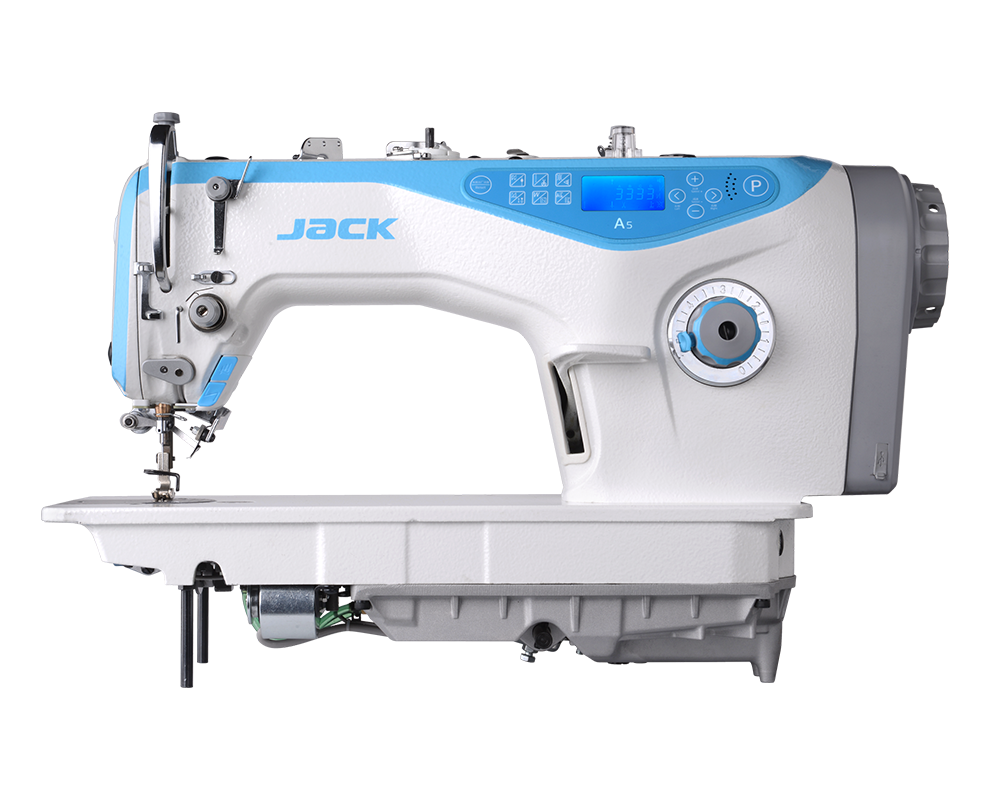A Jack Sewing Machine of Raj & Co
A Jack Sewing Machine is a machine used to sew fabric and materials together with thread. Sewing machines were invented during the first Industrial Revolution to decrease the amount of manual sewing work performed in clothing companies.
Home sewing machines are designed for one person to sew individual items while using a single stitch type at a time. In a modern sewing machine, the process of stitching has been automated so that the fabric easily glides in and out of the machine without the inconvenience of needles, thimbles and other tools used in hand sewing.
Early sewing machines were powered by either constantly turning a handle or with a foot-operated treadle mechanism. Electrically-powered machines were later introduced.
Industrial sewing machines, by contrast to domestic machines, are larger, faster, and more varied in their size, cost, appearance, and task.
Invention
Charles Fredrick Wiesenthal, A German-born engineer working in England, was awarded the first British patent for a mechanical device to aid the art of sewing, in 1755. His invention consisted of a double pointed needle with an eye at one end.
Newton Wilson’s copy of Saint’s sewing machine
Thomas Saint’s chain stitch used on the first ever complete sewing machine design for leather work. An awl preceded the eye pointed needle to make a hole in preparation for the thread.
Animation of a modern sewing machine as it stitches
In 1790, the English inventor Thomas Saint invented the first sewing machine design. His machine was meant to be used on leather and canvas material.
It is likely that Saint had a working model but there is no evidence of one; he was a skilled cabinet maker and his device included many practically functional features: an overhanging arm, a feed mechanism (adequate for short lengths of leather), a vertical needle bar, and a looper.
Saint created the machine to overall reduce the amount of hand-stitching on garments, making sewing more reliable and functional.
The following are some other types of sewing machines in Sholinganallur and Kelambakkam
- Lock stitch machine
- Chain stitch machine
- Double chain stitch machine
- Buttonhole machine
- Button stitch machine
- Bar-tack machine
- Feed off arm machine
- Over-lock machine
- Blind stitch machine
- Over-edge machine
Basic Stitches
The bobbin driver of a Husqvarna 3600 sewing machine
Sewing machines can make a great variety of plain or patterned stitches. Ignoring strictly decorative aspects, over three dozen distinct stitch formations are formally recognized by the ISO 4915:1991 standard, involving one to seven separate threads to form the stitch.
Plain stitches fall into four general categories: chainstitch, lockstitch, overlock, and coverstitch.
Chainstitch
The basic chain stitch
Chainstitch was used by early sewing machines and has two major drawbacks:
The stitch is not self-locking, and if the thread breaks at any point or is not tied at both ends, the whole length of stitching comes out. It is also easily ripped out.
The direction of sewing cannot be changed much from one stitch to the next, or the stitching process fails.
A better stitch was found in the lockstitch. The chainstitch is still used today in clothing manufacture, though due to its major drawbacks, it is generally paired with an overlock stitch along the same seam.
Lockstitch
Formation of a lock-stitch using a boat shuttle as employed in early domestic machines.
Lockstitch utilizing a rotating hook invented by Allen B Wilson. This is employed on many modern machines.
Formation of the double locking chain stitch
Lockstitch is the familiar stitch performed by most household sewing machines and most industrial “single needle” sewing machines, using two threads, one passed through a needle and one coming from a bobbin or shuttle.
Each thread stays on the same side of the material being sewn, interlacing with the other thread at each needle hole by means of a bobbin driver.
As a result, a lockstitch can be formed anywhere on the material being sewn; it does not need to be near an edge.
Sewing machine services in Medavakkam and Kelambakkam
All repairs are done at our Shop. We will give you a free estimate. Same day repairs are available depending how busy we are, otherwise most repairs are done in one day. If a repair cannot be done in one day, it is usually because parts need to be ordered.
If you are sending a machine for repair, pack the machine well and insure it. We will try our best to fix the machine the day it is received and ship it back out the next business day. Shipping charges are the responsibility of the customer.









